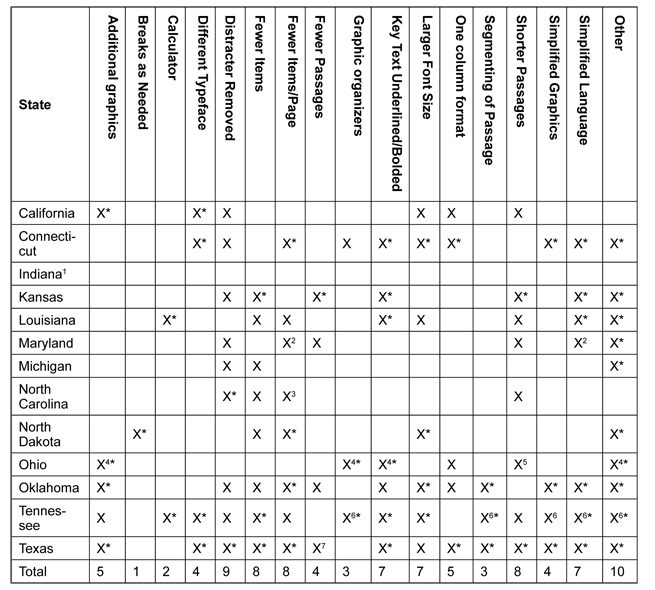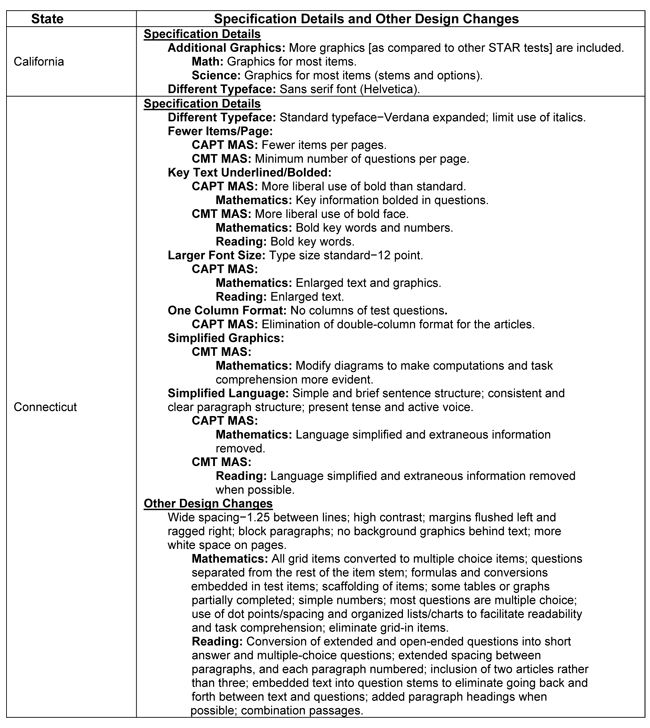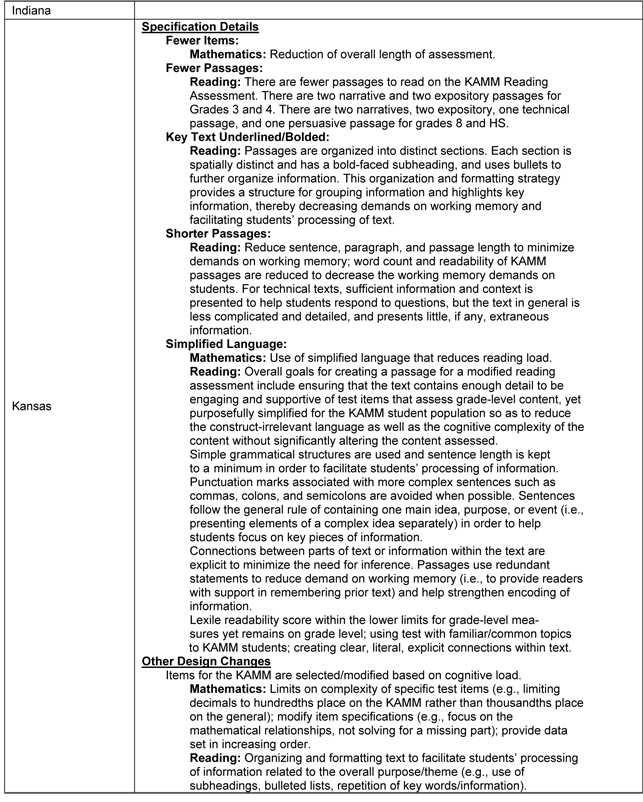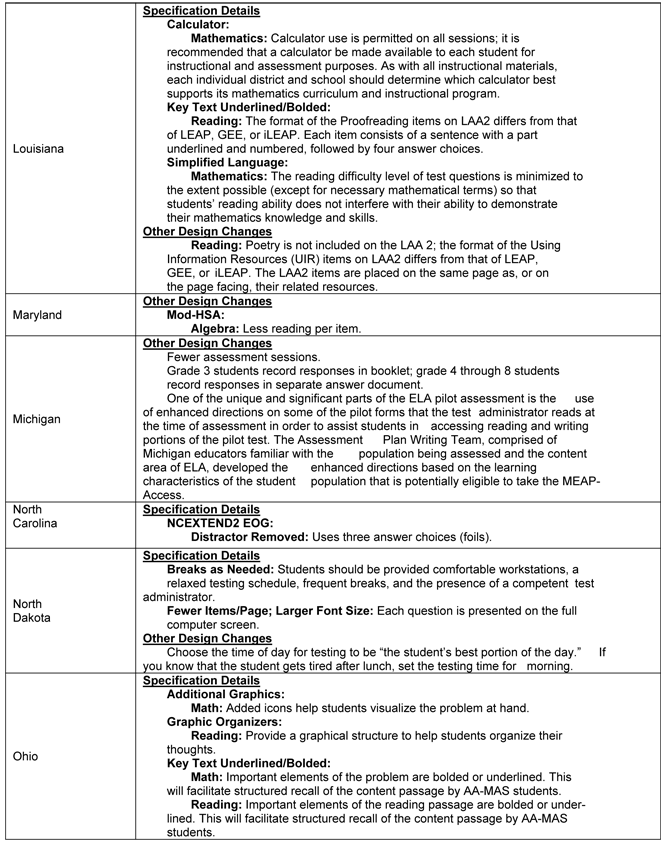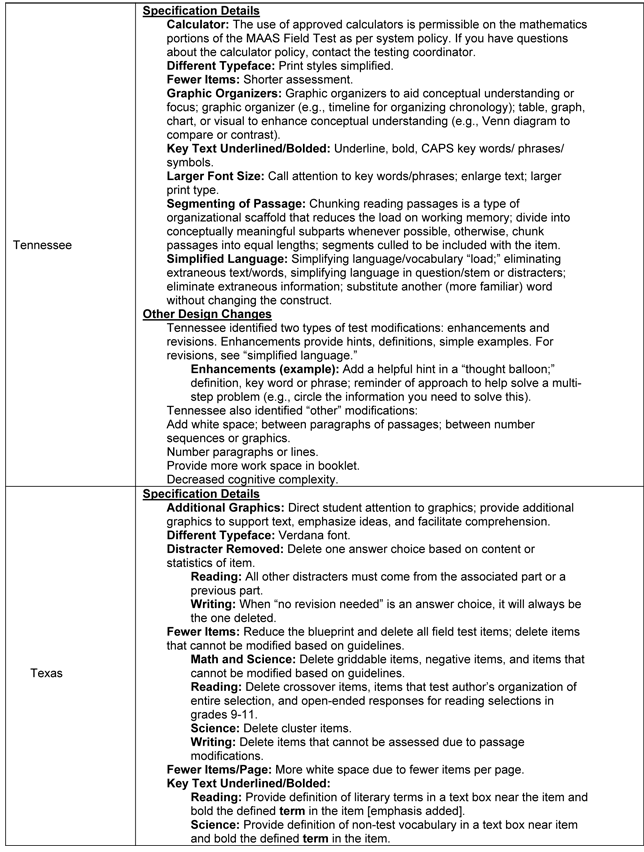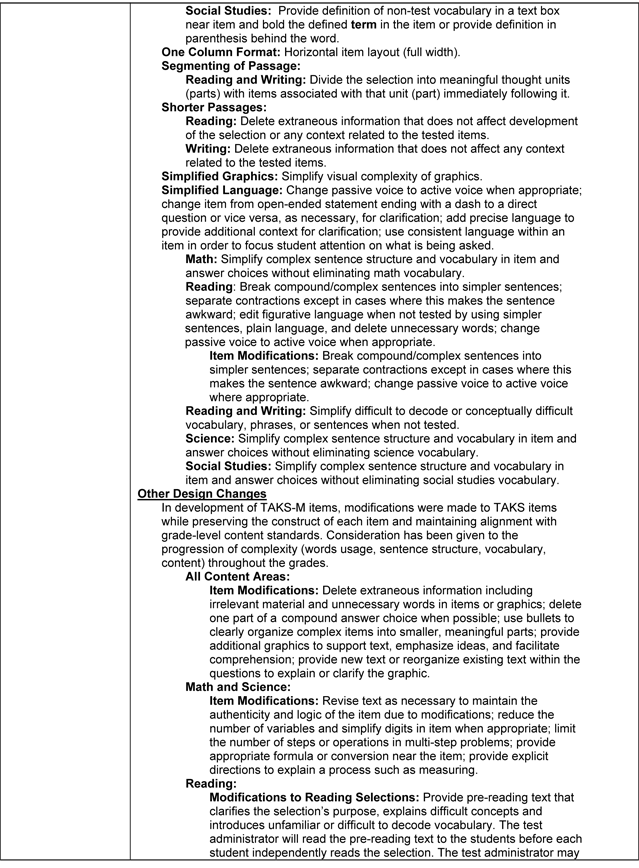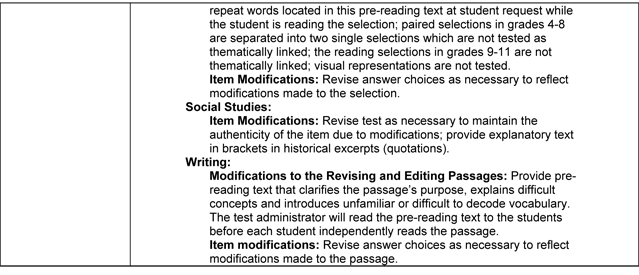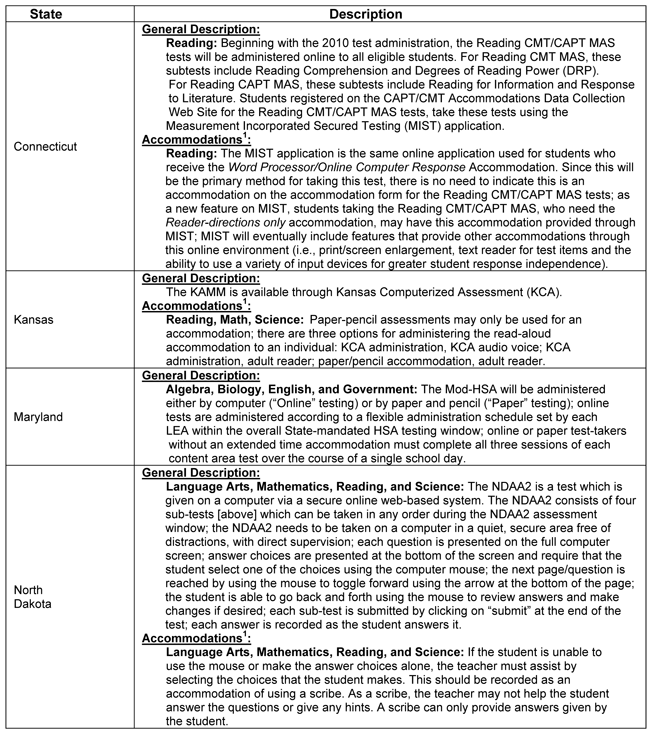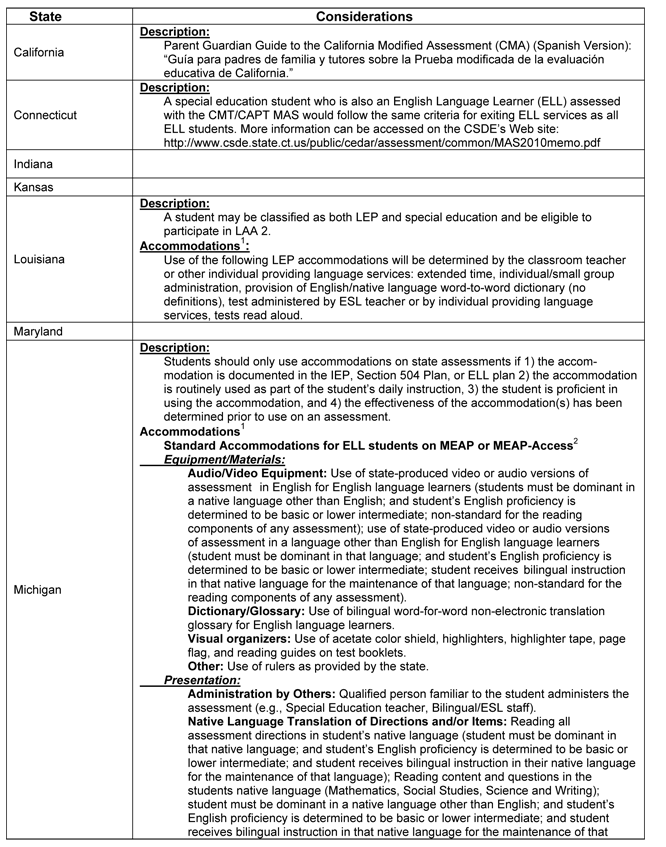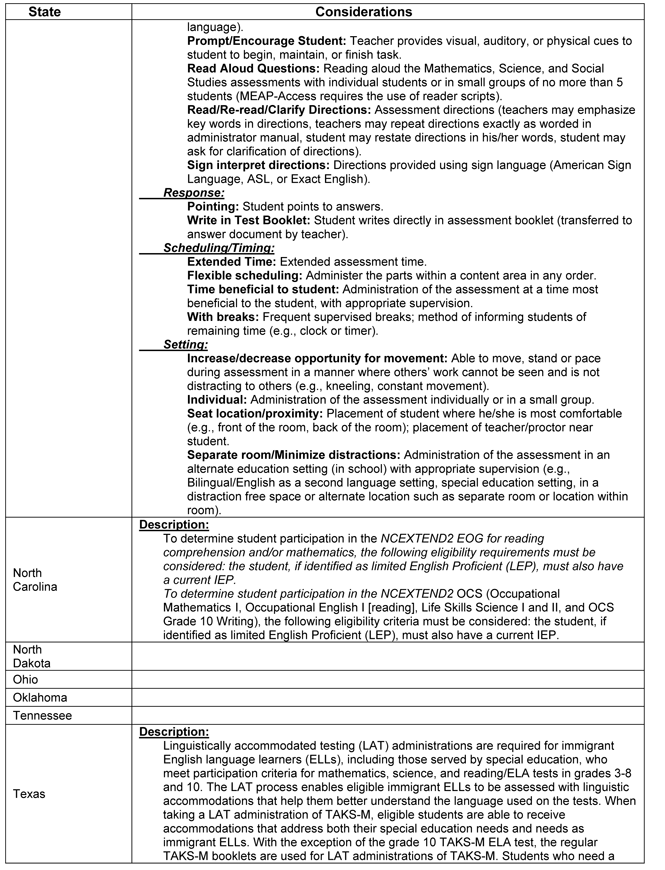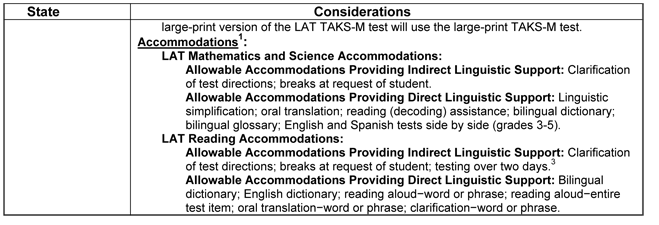Characteristics of States’ Alternate Assessments Based on Modified Academic Achievement Standards in 2009-2010Synthesis Report 80Jennifer R. Hodgson • Sheryl S. Lazarus • Martha L. Thurlow November 2010 All rights reserved. Any or all portions of this document may be reproduced and distributed without prior permission, provided the source is cited as: Hodgson, J. R., Lazarus, S. S., & Thurlow, M. L. (2010). Characteristics of states’ alternate assessments based on modified academic achievement standards in 2009-2010 (Synthesis Report 80). Minneapolis, MN: University of Minnesota, National Center on Educational Outcomes. Table of Contents
Executive SummaryAll students, including students with disabilities, participate in state accountability systems. Many students participate in the regular assessment, with or without accommodations, but some students may require participation in an alternate assessment to demonstrate their knowledge and skills. Students with more significant cognitive disabilities may be eligible for the alternate assessment based on alternate achievement standards (AA-AAS). In 2007, federal regulations introduced another assessment option—the alternate assessment based on modified academic achievement standards (AA-MAS). Eligible students may be from any disability category, but they must have Individualized Education Program (IEP) goals based on grade-level content standards. The National Center on Educational Outcomes (NCEO) has been tracking the characteristics of state’s AA-MAS since 2007. According to the 2008 NCEO update on test characteristics, nine states had developed what they considered to be an AA-MAS, and only one state (Texas) had received federal approval. The current report found 13 states that by the 2009-10 school year had developed, or were developing, what they considered to be an AA-MAS, and two additional states (Kansas and Louisiana) had received federal approval. In comparison to Albus et al. (2009), the current report found that more states were using constructed response items and fewer states were using performance task items. The current report also tracked test design changes between the AA-MAS and regular assessment. Over half of the states incorporated the following test design changes: distractor removed, fewer items, fewer items per page, key text underlined or bolded, larger font size, shorter passages, and simplified language. In the current analysis three test design changes tracked previously (manipulatives, read-aloud questions and answers, and scribe) were not found for any states. Five test design changes (e.g., additional graphics, graphic organizers, simplified graphics, different typeface, one column format), which were not tracked in previous reports, were included in the current study. This study also tracked whether states’ AA-MAS were computer-based and whether the states’ documents included considerations for English language learners (ELLs) with disabilities. Four of the thirteen states had a computer-based test. Documents from six states suggested that the needs of ELL students participating in the AA-MAS were considered. Top of page | Table of Contents OverviewFederal legislation requires that all students participate in state accountability systems. For students with disabilities, there are a variety of options for participation. Most students with disabilities participate in the regular assessment, with or without accommodations. Students with more significant cognitive disabilities may be eligible for an alternate assessment based on alternate achievement standards (AA-AAS). In 2007, federal regulations provided another assessment option for students with disabilities— alternate assessment based on modified achievement standards (AA-MAS). Students who participate in an AA-MAS may be from any disability category, and their IEP goals must align with grade-level content standards. According to the regulations, students who participate in this option must have access to grade-level content, but be unlikely to achieve grade-level proficiency within the time period covered by their IEP. For accountability purposes, states may count up to two percent of all students as proficient who met proficiency standards with an AA-MAS (U.S. Department of Education, 2007). States are not required to offer this assessment option. The National Center on Educational Outcomes (NCEO) has annually tracked and analyzed the test characteristics of states’ AA-MAS since 2007 (Albus, Lazarus, Thurlow, & Cormier, 2009; Lazarus, Thurlow, Christensen, & Cormier, 2007). This report updates Albus et al. A companion report on states’ participation guidelines for the AA-MAS in 2009 (Lazarus, Hodgson & Thurlow, 2010) can be found at the NCEO Web site at www.nceo.info. Need to Update and AnalyzeDuring the 2008-2009 academic year, NCEO compiled and analyzed information about the test characteristics of states’ AA-MAS, and found that nine states had either implemented or were in this process of developing a test that the states considered to be an AA-MAS. Only one state in the 2008 report (Texas) had received federal approval for its AA-MAS (Albus et al., 2009). As of August 2010, two additional states (Kansas and Louisiana) had successfully completed the federal peer review process. Because the AA-MAS is a relatively new assessment option, the characteristics of these tests have changed frequently. As more states develop an AA-MAS, and as states revise their tests, there is a need to identify and analyze these changes to help states make informed decisions. Previous reports also did not track some key differences across states (e.g., considerations for ELLs; whether the tests were computer-based). We wanted to learn whether the characteristics of this assessment were continuing to rapidly change. The research questions were:
Process Used to Find Information about States’ AA-MASIn February 2010, state department of education Web sites were searched to identify states that had a test they considered to be an AA-MAS, or an AA-MAS in development. Thirteen states were identified. State documents on AA-MAS test characteristics were downloaded for all 13 states, including fact sheets, guides, newsletters, and test administration manuals. Item samplers were also downloaded to compare items from states’ AA-MAS with items from the regular assessments. The documents used in this analysis are listed in Appendix A. The current report is an annual update. We surveyed AA-MAS test characteristics for the 2009-2010 academic year. In the previous NCEO report on AA-MAS test characteristics (Albus et al., 2009), researchers surveyed documents for the 2008-2009 school year; but referred to 2008 in the report. However, Albus et al. collected information earlier in the school year (August 2008) than we did for the current report (February 2010); therefore in this report we refer to the 2009-10 school year. In Albus et al. (2009), researchers tracked and analyzed test design changes as well as embedded accommodations on states’ AA-MAS. Embedded accommodations were defined in Albus et al. as accommodations that had been integrated into state’s AA-MAS test design. However, it sometimes was difficult to distinguish between an embedded accommodation and a test design change. This report does not distinguish between test design changes and embedded accommodations; all embedded accommodations from the previous report are considered test design changes in the current report. All named test changes in the previous report (Albus et al., 2009) were included in this report if any states made the change this year. If at least three states made a change that was not included in the previous report, we included it in this report. However, it should be noted that many of these changes were listed in previous NCEO reports as “Other.” Information was provided about these changes in the appendix tables of Albus et al. (2009) that provided detailed descriptions. This year we also added information about states with materials that addressed considerations for ELLs with disabilities who were taking the AA-MAS. The initial search for states’ test design changes revealed that one state (Texas) had posted considerations for English Language Learners (ELLs) with disabilities on the AA-MAS. Thus, a second search was conducted in March 2010 to identify other states that had posted considerations for ELLs with disabilities on the AA-MAS. Several other states were found and a summary of states’ considerations for ELLs with disabilities is included in Appendix B. In May 2010, state profiles were prepared and sent to state directors of assessment via e-mail. Each profile contained the AA-MAS information that had been collected for a state. States were asked to verify the information. If the profile contained inaccurate information, states were permitted to revise their profiles, provided we could confirm their changes with posted state information. All states that had not responded within two weeks were sent a follow-up e-mail. A total of nine states responded. They either confirmed the accuracy of the information, suggested one document over another, or filled in other information. If a state did not respond to the requests, we assumed that the data were correct and considered it verified. The verified information is summarized in this report. Top of page | Table of Contents ResultsNine states (California, Connecticut, Kansas, Louisiana, Maryland, North Carolina, North Dakota, Oklahoma, and Texas) were identified as having publicly available information on test characteristics for an AA-MAS in the previous report (i.e., during the 2008-2009 academic year). Four additional states (Indiana, Michigan, Ohio, and Tennessee) were identified in the current report. Table 1 provides the state, the name of the state’s AA-MAS, as well as the content area and grade. Table 1. AA-MAS Name, Content Area, and Grade Described by State
1 The high school CAPT MAS available as a live test for identified grade 10 students and as a retest for individual students in grade 11 and 12. 2 Indiana’s assessment based on modified academic achievement standards has yet to be named. 3 Kansas offers KAMM Opportunity to Learn (OTL) assessments for grades 9-12 in Math, Reading, and Science. The OTL assessments are designed to give students the opportunity to learn the content standards prior to participation. This assessment option “provides Kansas High Schools with flexibility in determining when to assess students” (p. 66, see 2009-2010 Kansas Assessment Examiner’s Manual).
All states in the current report assessed students in reading and mathematics. Some states also had AA-MAS tests for science, social studies or other content areas. Some states offered the AA-MAS in grades 3-8 and at the high school level, while other states offered the test at fewer grade levels. Some states had operational assessments across all content areas, while in other states the AA-MAS was in development across some or all content areas. Figure 1 shows that nine states had an operational assessment that they considered to be an AA-MAS, one state had an operational assessment in some content areas but in development in others, and three states were still in the development stage. Data in Figure 1 represent all 13 states in this analysis. See Table 1 in Appendix B for details. Figure 1. Number of States with an Operational AA-MAS as of January 2010
States’ AA-MAS included different types of questions and approaches. Figure 2 presents the number of states across 2008-2009 and 2009-2010 with information on AA-MAS question characteristics. In 2009-10, one state (Indiana) was not included because question characteristics for the AA-MAS had not yet been posted when the data were collected. Data in Figure 2 for 2009-10 reflect 12 states. States with multiple choice, constructed response, performance task items, and writing prompts were identified. In Figure 2, states were included in a category if the item type was used in at least one subject area. States were not counted more than once in any category. For example, if a state used multiple choice and constructed response questions in one content area, the state would be counted in both categories. But a category such as constructed response would not be counted twice if it was used for both reading and mathematics. Most states (n=12) had multiple choice items. The number of states using constructed response items increased relative to the previous report, and the proportion of states using constructed response items on the AA-MAS increased from 22% in 2008-2009 to 33% in 2009-2010. The number of states using writing prompts for the AA-MAS in at least one subject area did not change from 2008-2009 to 2009-2010. However, the percentage of states using a writing prompt decreased from 2008-2009 (56%) to 2009-2010 (42%). The number of states using performance task items also decreased relative to last year (from two states to one). Figure 2. Number of States by Question Characteristic across Study Years
Note: This figure is based on the responses of 12 states.
Assessment Design ChangesThe previous NCEO report tracked six test design changes (distractor removed, fewer items, fewer passages, segmenting of passages, shorter passages, and simplified language) and eight embedded accommodations (breaks as needed, calculator, fewer items/page, key text underlined/bolded, larger font size, manipulatives, read aloud questions and answers, and scribe). As previously discussed all embedded accommodations were considered test design changes in the current report. Figure 3 compares states’ AA-MAS test design changes from 2008-2009 to 2009-2010. All states in the current report except one (Indiana) had posted information on AA-MAS test design changes when the data were collected. Figure 3 data for 2009-10 reflect 12 states. In addition, three test design changes tracked previously (manipulatives, read-aloud questions and answers, and scribe) were not found for any states in 2009-10. One state had made each of these changes in 2008-09. Figure 3. States’ Assessment Design Changes for the AA-MAS across Study Years
Note: This figure is based on the responses of 12 states. Figure 3 shows that states’ design changes for the AA-MAS varied across study years. In the current study, states were most likely to remove a distractor on the AA-MAS (n=9 states). Fewer items, fewer items per page, and shorter passages were also popular test design changes for states’ AA-MAS. The largest increase was observed for states using “key text underlined/bolded,” from 33% of states in 2008-2009 to 58% of states in 2009-2010. Few states indicated that they used segmenting of passages, calculator, or breaks as needed. In the 2008-2009 report, Oklahoma indicated “breaks as needed,” whereas only North Dakota had “breaks as needed” in the current analysis. States sometimes provide detailed descriptions about certain test design changes. These specifications are presented in Table B4 in Appendix B. Selected AA-MAS test design change specifications are discussed in more detail here. Additional graphics. Documents from five states (California, Ohio, Oklahoma, Tennessee, and Texas) indicated that additional graphics were used on the AA-MAS. The specifications differed across states. Some indicated when graphics should be added. California’s documents said “graphics for most items” on the math and science tests. The specifications of some states indicated why graphics should be added. For example, Oklahoma indicated that for the science and U.S. history tests, “when possible use art instead of text.” Texas indicated that graphics should help “support text, emphasize ideas, and facilitate comprehension.” And, in Ohio, “Added icons help students visualize the problem at hand.” Calculator. Two states (Louisiana and Tennessee) integrated calculators into AA-MAS test design. Documents from both states indicated that calculators may be used on all sections of the mathematics test. For example, Louisiana’s documents said, “It is recommended that a calculator be made available to each student for instructional and assessment purposes.” Fewer Items per Page. Eight states (Connecticut, Louisiana, Maryland, North Carolina, North Dakota, Oklahoma, Tennessee, Texas) had fewer items per page on the AA-MAS than on the regular assessment. Oklahoma indicated that the AA-MAS had approximately “two or three items per page,” whereas Connecticut merely indicated “fewer items per page.” North Dakota’s AA-MAS had “fewer items per page” as a result of the test’s computer platform. Students taking the North Dakota Alternate Assessment 2 (NDAA2) received each item one at a time, presented on a full computer screen. Key Text Underlined/Bolded. Seven states (Connecticut, Kansas, Louisiana, Ohio, Oklahoma, Tennessee, Texas) had an AA-MAS that used underlining or bolding to emphasize key text. States varied in terms of how and when these formats were used. Some states provided specific descriptions to illustrate formatting changes on the AA-MAS. Kansas indicated that “Passages are organized into distinct sections. Each section is spatially distinct and has bold-faced subheading, and uses bullets to further organize information.” Texas documents indicated that key “terms” were emphasized on the AA-MAS: “Provide definition of non-test vocabulary in a text box near item and bold the defined term in the item.” Other states provided more general descriptions of how formatting changes were used on the AA-MAS. For example in Ohio, “Important elements of the problem are bolded or underlined.” Connecticut indicated that there was “a more liberal use of bold face” for its AA-MAS tests. Segmenting of Passages. Three states (Oklahoma, Tennessee, and Texas) indicated that segmenting of passages, generally for reading passages, was to be used on the AA-MAS. Two states (Tennessee and Texas) described segmenting as separating text into “meaningful” subparts. However, a definition of “meaningful” was not provided by either state. All three states said that related test items follow each segment of text. Oklahoma indicated that segmenting was “a type of modification used frequently in the classroom.” Tennessee documents described possible effects of segmenting for students with disabilities. Specifically, Tennessee indicated that segmenting is a “type of organizational scaffold that reduces the load on working memory.” Tennessee was also the only state to specify that text segments should be of equal length. Simplified Graphics. Of the four states (Connecticut, Oklahoma, Tennessee, Texas) with simplified graphics on AA-MAS tests, documents from two states (Connecticut, Oklahoma) described how graphics were simplified for specific content areas. Connecticut’s documents said, “modify diagrams to make computations and task comprehension more evident” on the math test. Oklahoma provided detailed specifications for the biology, math, science, and U.S. history tests. For example, “simplify cells and other diagrams,” on the biology test, and “simplify tables and charts by removing irrelevant rows or columns” on the science and U.S. history tests. Two states (Tennessee and Texas) indicated that graphics were simplified across all content areas. Texas’ documents said, “Simplify visual complexity of graphics.” Simplified Language. Documents from seven states (Connecticut, Kansas, Louisiana, Maryland, Oklahoma, Tennessee, Texas) suggested that some form of simplified language was used on the AA-MAS. As evidenced by AA-MAS test specifications, states ranged from very specific to more general for descriptions of “simplified language.” For example, Kansas included the following for the reading assessment: Simple grammatical structures are used and sentence length is kept to a minimum in order to facilitate students’ processing of information. Punctuation marks associated with more complex sentences such as commas, colons, and semicolons, are avoided when possible. Sentences follow the general rule of containing one main idea, purpose, or event (i.e., presenting elements of a complex idea separately) in order to help students focus on key pieces of information. Two states (Texas and Louisiana) specified that only text unrelated to the content being tested was allowed to be simplified. For example, for the math test Louisiana’s documents said, “The reading difficulty level of test questions is minimized to the extent possible (except for necessary mathematical terms) so that students’ reading ability does not interfere with their ability to demonstrate their mathematics knowledge and skills.” Other states were more general in their description of “simplified language.” For example, Oklahoma said, “Optimize readability, where appropriate, by shortening and/or simplifying text stimuli.”
Computer-based TestsSeveral states were integrating technology into their AA-MAS. As represented in Figure 4, some states (n=4) had developed computer-based tests (CBTs) across several content areas for the AA-MAS, while other states had developed CBTs across one or fewer content areas. Figure 4. State’s Computer-based Tests for the Modified Assessment by Content Area
In North Dakota in 2008-2009, it was reported that the state had developed a teacher-mediated modified assessment wherein the teacher would assist the student in responding to items presented on the computer: Test is done on computer with the student and teacher together. The teacher enters the answer choice given by the student. Each question is presented on a single screen. Most questions are multiple choice with several teacher initiated questions (involves printing a screen shot of the item, providing student with supplies to answer the item, give verbal instructions to student. The instructions provided with the item and the teacher rates the student’s response from several options). (Albus et al., 2009) In the current analysis, no evidence of a teacher-mediated CBT was found. Teachers were to monitor students who were independently taking the CBT. As described in 2009-2010 North Dakota state documents: If the student is unable to use the mouse or make the answer choices alone, the teacher must assist by selecting the choices that the student makes. This should be recorded as an accommodation of using a scribe. As a scribe, the teacher may not help the student answer the questions or give any hints. A scribe can provide only the answers given by the student. (As emphasized in document.)
English Language Learners (ELLs) and AA-MASDocuments from six states (California, Connecticut, Louisiana, Michigan, North Carolina, Texas) suggested that the needs of ELL students participating in the AA-MAS were considered. Texas provided Linguistically Accommodated Testing (LAT) administrations of the Texas Assessment of Knowledge and Skills Modified (TAKS-M). LAT administrations were designed for ELL students who were eligible to participate in TAKS-M. All students were provided with “indirect linguistic support” during LAT testing. For Texas’s TAKS-M mathematics and science tests, this support included, “clarification of test directions,” and “breaks at request of student.” For the TAKS-M reading tests, this support included “clarification of test directions,” “breaks at request of student,” and “testing over two days.”
ELL considerations in Louisiana,
Michigan, and Texas specified which
accommodations an ELL student
participating in an AA-MAS may be
eligible to use. See Table 7 in Appendix
B for details (see Lazarus, Cormier,
Crone, & Thurlow, 2010, for general
information about AA-MAS accommodations
policies). Top of page | Table of Contents DiscussionIn the 2009-2010 academic year, 13 states had an assessment that they considered to be an AA-MAS. Nine states had an operational assessment, while four states were still in the process of developing the assessment. Only three states (Kansas, Louisiana, and Texas) had completed the U.S. Department of Education’s Peer Review process. Other important findings from NCEO’s 2009-2010 analysis of AA-MAS test characteristics include:
Specifications for test design changes, including simplified language and segmenting of passages, varied by state. A few states provided detailed specifications for these design changes. Other states provided more general information. For segmenting of passages, some states indicated that text was segmented into “meaningful” parts, but it was not clear if “meaningful” was defined similarly in all states. Several states considered whether test design changes for the AA-MAS were also used during instruction. One state said that segmenting of passages was “used frequently in the classroom.” Another state indicated the importance of using test changes that a student who took the AA-MAS would encounter during instruction (for example, that calculators should be used for instruction and assessment). This follows good practice. Students need to know how to use any test design changes prior to test day. Test design changes for the AA-MAS—while different from accommodations—have many similarities. Students generally should have previously used during instruction any assessment accommodations. According to Pugalee and Rickelman (2010), test design changes for the AA-MAS are often “good instructional tools” that should be introduced to students well before test day. Some AA-MAS test design changes may increase test accessibility for students, but they may also pose some challenges (Pugalee & Rickelman, 2010; Welch & Dunbar, 2010). These changes may result in more opportunities for students to demonstrate their skills, as well as decreased construct irrelevant variance due to presence of a disability. However, these changes also present challenges, including difficulty in comparing performance on the AA-MAS to performance on the regular test. States may also sometimes fail to align modified test specifications with grade-level content standards (Welch & Dunbar). And, “some low performing students may not have had access to grade-level content, which is another requirement of the federal regulations” (Lazarus, Wu, Altman, & Thurlow, 2010, p. 4). Some states added graphics for only a few content areas (e.g., math and science) while other states added graphics across all content areas. Moreover, the intended purpose of added or simplified graphics varied across states. One state indicated that graphics were provided instead of text to reduce reading load, while another state said that graphics were simplified on the math test to help students understand the problem. Sometimes graphics can distract or confuse the student. States should carefully consider whether the additional graphics provide useful, accessible information. In addition, states discontinued some design changes for 2009-2010. For example, one state discontinued use of a scribe. It is no longer provided for all students eligible for this assessment option. To receive assistance from a scribe, students must have a documented need. Thus, it appears that some states are substituting test design changes, which are provided for all students taking the AA-MAS, with accommodations provided for individual students. During the verification process, it was found that some states had information on AA-MAS test design that was not posted on the state Web site. States should consider putting additional information about their AA-MAS on the state site where it will be easily accessible to all interested parties, including students, parents, teachers, as well as IEP team members. Teachers may especially need to know about test features that students might need practice using prior to test day (for example, graphic organizers, hint boxes).
NCEO will continue to track test design
changes for the AA-MAS. As states seek
to better assess students who may be
candidates for an AA-MAS, it is
anticipated that states will make
additional test design changes. Top of page | Table of Contents ReferencesAlbus, D., Lazarus, S. S., Thurlow, M. L., & Cormier, D. (2009). Characteristics of states’ alternate assessments based on modified academic achievement standards in 2008 (Synthesis Report 72). Minneapolis, MN: University of Minnesota, National Center on Educational Outcomes. Lazarus, S. S., Cormier, D. C., Crone, M., & Thurlow, M. L. (2010). States’ accommodations policies for alternate assessments based on modified achievement standards (AA-MAS) in 2008 (Synthesis Report 74). Minneapolis MN: University of Minnesota, National Center on Educational Outcomes. Lazarus, S. S., Hodgson, J., & Thurlow, M. L. (2010). States participation guidelines for the alternate assessment based on modified achievement standards in 2009 (Synthesis Report 75). Minneapolis MN: University of Minnesota, National Center on Educational Outcomes. Lazarus, S. S., Thurlow, M. L., Christensen, L., & Cormier, D. (2007). States’ alternate assessments based on modified achievement standards (AA-MAS) in 2007 (Synthesis Report 67). Minneapolis MN: University of Minnesota, National Center on Educational Outcomes. Lazarus, S. S., Wu, Y., Altman, J., & Thurlow, M. L. (2010). The characteristics of low performing students on large-scale assessments (NCEO Brief). Minneapolis MN: University of Minnesota, National Center on Educational Outcomes. Pugalee, D. K., & Rickelman, R. J. (2010). Understanding the content: A focus on reading and mathematics. In M. Perie (Ed.), Teaching and assessing low-achieving students with disabilities: A guide to alternate assessments based on modified achievement standards (pp. 113-148). Baltimore, MD: Brookes Publishing. U.S. Department of Education (2007, April 9). Final Rule 34 CFR Parts 200 and 300: Title I-Improving the Academic Achievement of the Disadvantaged; Individuals with Disabilities Education Act (IDEA). Federal Register. 72(67), Washington DC: Author. Retrieved from http://cehd.umn.edu/NCEO/2percentReg/FederalRegApril9TwoPercent.pdf. Welch, C., & Dunbar, S. (2010). Developing items and assembling test forms for the alternate assessment based on modified achievement standards. In M. Perie (Ed.), Teaching and assessing low-achieving students with disabilities: A guide to alternate assessments based on modified achievement standards (pp. 149-183). Baltimore, MD: Brookes Publishing. Top of page | Table of Contents Appendix AState Documents Used in AnalysisState documents and presentations used in the analysis of states’ AA-MAS
Top of page | Table of Contents Appendix BAA-MAS Characteristics by StateTable B1. AA-MAS Name, Content Area, and Grade Described by State
1 CAPT MAS available as a live test for identified grade 10 students and as a retest for individual students in grade 11 and 12. 2 Indiana’s assessment based on modified academic achievement standards has yet to be named. 3 Kansas offers KAMM Opportunity to Learn (OTL) assessments for grades 9-12 in Math, Reading, and Science.
Table B2. Assessment Type and Question Characteristic by Content Area for States’ AA-MAS, 2010
Shading indicates a state does not have a separate assessment for that content area. 1 California’s plans to implement the following additional CMA assessments no later than Spring 2011: CMA for Algebra I (for eligible students in grades three through seven); CMA for Geometry (for eligible students in grades eight through eleven); and CMA for Life Science in grade ten. In fall 2009, California field tested the CMA for Algebra I and the CMA for Life Science. 2 Connecticut’s Mastery Test Modified Assessment System (CMT MAS) and Connecticut’s Academic Performance Test (CAPT) Modified Assessment System (MAS) are both available for Reading and Mathematics. 3 Indiana does not have information on question characteristics posted online. 4 No information on question characteristics found for Maryland Modified School Assessment (Mod-MSA). Maryland Modified High School Assessment (Mod-HSA) covers the following content areas: Algebra, Biology, English, and Government. 5 North Carolina’s NCEXTEND2 for Occupational Course of Study covers the following content areas: Occupational English I, Occupational Mathematics I, and Life Skills Science I and II, and Grade 10 Writing. 6 The English II EOI Modified Assessment has 40 multiple choice items and one writing prompt. Students eligible for the OMAAP in grades 5 and 8 must take the general writing assessment. Likewise, students eligible for the OMAAP in grades 5, 7, and 8 must take the general assessment for social studies, geography, and U.S. History, Constitution, and Government. 7 TAKS-M includes a writing prompt for students taking the Writing tests in grades 4 and 7, as well as students in grades 10 and 11 taking the English Language Arts (ELA) test.
Table B3. Comparison of AA-MAS and Regular Assessment: Design Changes, 2010
*See Table B4 for specifications and for descriptions of “other” design changes. 1 Indiana does not have information on design changes posted online. 2 Indicates design change that was identified via visual comparison of AA-MAS and regular assessment item samplers for Maryland’s High School Assessment (HSA). These changes were not explicitly identified in state documents. 3 Indicates design change that was identified through visual comparison of AA-MAS and regular assessment item samplers for North Carolina’s end-of-grade (EOG) assessments. These design changes were not explicitly identified in state documents. 4 Indicates design change on Ohio’s AA-MAS Spring 2009 pilot. 5 Design change identified via analysis of Ohio’s regular and AA-MAS practice tests for Grade 7. Not explicitly identified in state documents. 6 Tennessee identified “possible” design changes for the TCAP MAAS. 7 Design change identified though comparison of released tests for the regular test and AA-MAS. Not explicitly stated in state documents.
Table B4. Specifications and Descriptions of Assessment Design Changes and of “Other” Assessment Design Changes, 2010
Table B5. Online or Computer-Based Testing for States’ AA-MAS, 2010
Shading indicates a state does not have a separate assessment for that content area. *See Table B6 for descriptions of states’ online or computer-based testing for AA-MAS.
Table B6. Description of States’ Online or Computer-based Testing for AA-MAS, 2010
1 For additional information about AA-MAS accommodations policies, see Lazarus, Cormier, Crone & Thurlow (2010).
Table B7. States’ Considerations for ELL Students with Disabilities on AA-MAS, 2010
1 For additional information about AA-MAS accommodations policies, see Lazarus, Cormier, Crone & Thurlow (2010). 2 Categories and definitions for accommodations were added, based on Lazarus et al. (2010). 3 A two-day LAT administration of a TAKS-M reading/ELA test is optional. The LPAC and ARD committee should decide in advance whether the student should complete the test in one or two days. |






